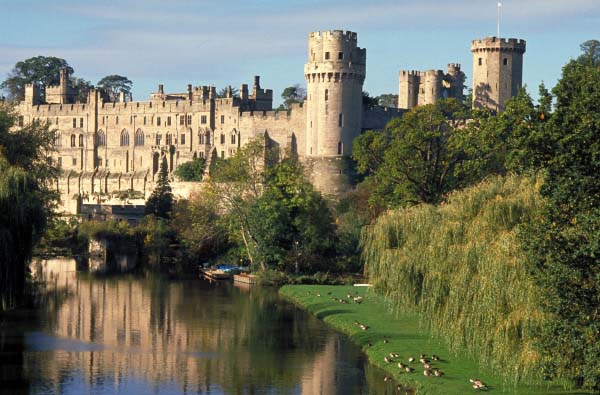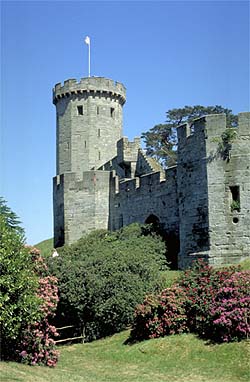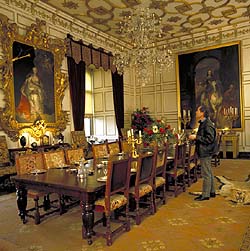Warwick Castle's Ghost Tower
by Jean Bellamy
The atmosphere of magnificent Warwick Castle is redolent of
secrecy, mystery and intrigue, and to enter the spooky,
fourteenth century Ghost Tower is a somewhat scary experience.
Decorated in Jacobean style, with a gateway leading from the base
to the river, this tower is said to be haunted by the restless
spirit of Sir Fulke Greville, who was murdered there by his
manservant.

A prominent Elizabethan-Jacobean courtier, Greville lived from
1554 to 1628 and was a gifted poet. Warwick Castle was granted to
him in 1604 by James I, and he was at one time Chancellor of the
Exchequer. On leaving this post in 1621, he was raised to the
peerage and given the title of Baron Brook.
 The castle had
fallen into a state of advanced decay, and from the date he
acquired it until his death, Greville devoted his time and
fortune to its restoration. The gardens he planted were said to
be unparalleled in this part of England, though during the Civil
war they were dug up for gun emplacements by the garrison
defending the castle. The castle had
fallen into a state of advanced decay, and from the date he
acquired it until his death, Greville devoted his time and
fortune to its restoration. The gardens he planted were said to
be unparalleled in this part of England, though during the Civil
war they were dug up for gun emplacements by the garrison
defending the castle.
Inside the gloomy Ghost Tower, creaks, groans and mutterings
emanate from dark doorways as one explores the two rooms, one up
one down, in which Greville lived whilst the castle was
undergoing repairs. As one climbs the stairs to the bedroom, low
voices, recounting the chilling tale of the murder, penetrate the
inky blackness. They tell how, while Greville and one of his
man-servants are away in London, an argument breaks out between
the two men. It concerns the contents of Greville's will, Ralph
Heywood, the manservant, being convinced that his master, however
generous in his plans for the restoration of the castle, has been
less so towards himself. Believing that Greville has not
bequeathed to him his rightful due he draws a knife and stabs Sir
Fulke; after which, realizing the enormity of the deed he has
committed, he turns the blade on himself and dies immediately.
Greville, however, lingers on in agony, until after 27 days,
despite the efforts of his surgeons, he too succumbs. His body is
brought from London back to Warwick Castle, and he is laid to
rest in St. Mary's Church in the town. His ghost, it is said,
still haunts the tower that was once his home; for dying an
unnatural death, his soul is said to be unquiet. On his death,
Greville being unmarried and without heirs, the estate goes to
his adopted heir, Robert Greville, the second Lord Brooke.
Exploring Warwick Castle takes the visitor back over thousands of
years of history. In particular, one may tour the recently opened
'Kingmaker's' exhibition with its realistic scents and smells.
Here is brought to life a medieval household preparing for the
final battle of Warwick the Kingmaker, who is shortly to die.
 By
way of contrast, the luxury of the state rooms presents a very
different aspect of life at Warwick castle. For here the waxwork
figures, which came into being when the castle was sold a decade
or so ago to Madame Taussaud's, transport the visitor back to
Victorian times. In the gardens, peacocks display in front of the
Conservatory, the latter built in 1786 to house the Warwick Vase,
an enormous piece of ancient Roman pottery excavated near Tivoli
in 1771. A replica of the vase now occupies the conservatory
which has reverted to its use in Victorian times as a glasshouse
growing exotic plants. By
way of contrast, the luxury of the state rooms presents a very
different aspect of life at Warwick castle. For here the waxwork
figures, which came into being when the castle was sold a decade
or so ago to Madame Taussaud's, transport the visitor back to
Victorian times. In the gardens, peacocks display in front of the
Conservatory, the latter built in 1786 to house the Warwick Vase,
an enormous piece of ancient Roman pottery excavated near Tivoli
in 1771. A replica of the vase now occupies the conservatory
which has reverted to its use in Victorian times as a glasshouse
growing exotic plants.
Across the bridge lies the island where the river Avon separates
and flows on either side. On this large area of land is a
Victorian boathouse, and here during the 1890s the Countess of
Warwick kept a small menagerie comprising a baby elephant, some
Japanese deer, a flock of Chinese geese, an emu, raccoons, and an
antbear. When the elephant grew too large, it was given away to
an animal trainer in Lymington, while the emu achieved fame when
it chased a bishop through the castle grounds.
For the energetic, exploring the ramparts and fortifications and
climbing the towers with their numerous steps is another option.
Or one may visit another eerie location -- the silent dungeon and
torture chambers. Always provided one has survived the traumas of
the Ghost Tower, that is!
More Information:
We regret that we no longer have the resources to maintain up-to-date links and/or hours and pricing details for the various sites and attractions listed on this website. For more information about the location(s) listed above, please use your favorite search engine or visit Wikipedia.
Jean Bellamy has been writing since 1970, and is the author of over 300 published articles and short stories. She has written three children's novels (all with a "West Country flavour"). A resident of Dorset, she is the author of several local history books, including Treasures of Dorset, A Dorset Quiz Book, Second Dorset Quiz Book, Dorset Tea Trail, Dorset as she was spoke, Little Book of Dorset, 101 Churches in Dorset, and Cornwall: A Look Back. Jean loves to explore and write on all things British.
Article © 2006 Jean Bellamy
Photos courtesy of Britainonview.com
|
